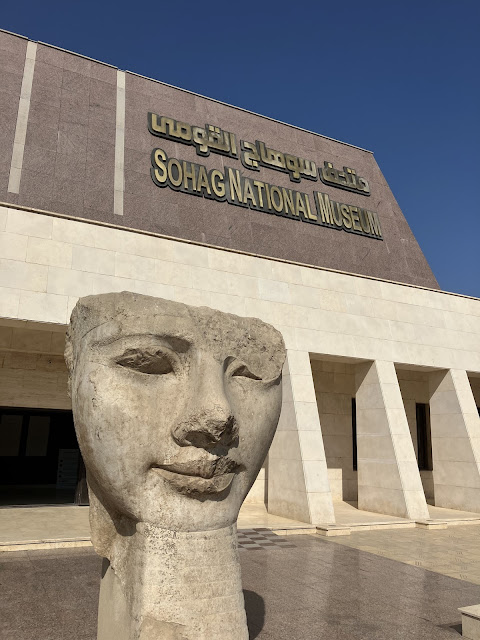It is a powerful way to take a topic with cultural value and make it visible and tangible for museum visitors. There are a number of qualities that define an excellent museum display; the most important one is an engaging story.
In the case of the regional museums of Upper Egypt, several approaches to displaying Egyptian heritage are presented. Such museums are shaped by evolving community values and senses of Egyptian history where every museum tells a different story. The objective of this paper is to clarify the current display of regional museums in Upper Egypt especially in the case of Sohag National Museum analyzing its mission, its civic and social responsibilities.
Effective storytelling, object material cultural and collection interpretation in Sohag National Museum‘s display recount historical events from a certain perspective and provide a stimulating experience that captures visitors’ full attention. Sohag National Museum
On 12/8/2018, President Abdel Fattah El-Sisi headed to the southern city to inaugurate the Sohag National Museum. The Sohag National Museum, which is overlooking the Sohag Nile, a few meters from Akhmim Bridge, consists of a "basement". It includes a number of artifacts that show the religious thought of the ancient Egyptians and the idea of resurrection and immortality, as well as the worship of pilgrimage in the Pharaonic, Coptic and Islamic times.
Storytelling has a critical role in human evolution. Using storytelling in the display of Egyptian Museums is a fundamental task of Museums Sector at the Egyptian Ministry of Antiquities. Storytelling adds a flavor to the fact and increases the interest in knowing1 . Using such interpretation tool at museums in Egypt is the latest trend. Display through storytelling enables the visitor to understand why the object is on display. Relevant stories of the museums’ objects reveal both the tangible and intangible heritage of the nation where every object has a story to tell.Sohag National Museum Currently considered in the museums of Upper Egypt, where using storytelling in the display provides the communication between the exhibit and the visitor. The paper aims at illustrating storytelling as a method of interpretation in the most recently opened museums in Egypt, where planning the displays of such museums started with research of the objects themselves and the stories they can tell .
The Sohag National Museum is the case study where the new approach of the display facilitates the communication between the material cultural heritage and the visitors. The ground floor and the main entrance include statues and archeological artifacts of the kings of the first and second families, as well as archeological artifacts, most of which are the result of archaeological discoveries in the governorate.
Some artifacts were transferred from the Egyptian Museum in El-Tahrir, Gayer-Anderson, the Coptic Museum and the Museum of Islamic Art to narrate the story of the governorate since ancient ages, especially in the era of the first and second families. This is in addition to addressing the heritage of the people of the governorate, shedding light on the customs and traditions of the family, and highlighting some industries that the governorate is famous for, including the textile industry in Akhmim.The museum also houses a collection of artifacts discovered in Sohag, kept in the archaeological stores to serve the presentation scenario. Based on the available data, the museum presentation scenario committee held an emergency meeting to select some artifacts. It was agreed to select pieces from the Egyptian Museum in El-Tahrir and some discoveries in the Abydos archaeological area. It is worth mentioning that the idea of establishing Sohag National Museum was first launched in 1993 and then its implementation was halted for engineering and technical issues. The work in the museum was resumed in 2006 and then stopped again after the 25 January Revolution before the Ministry of Antiquities continued working in it in 2015 in implementation of the directives of President Abdel Fattah El-Sisi, who called for paying interest to the governorates of Upper Egypt and revive tourism in order to resume work in 2016.The Soft Power of the Regional museums in Egypt Museums and cities throughout the world are connecting in a soft power embrace.5 Museums today shape the soft power and use its spaces not just for knowledge or education but the power of correcting, solving and changing thoughts and behaviors in the right directions. The term “Soft power” means the ability to shape the preferences of others. It is the ability to persuade













No comments:
Post a Comment